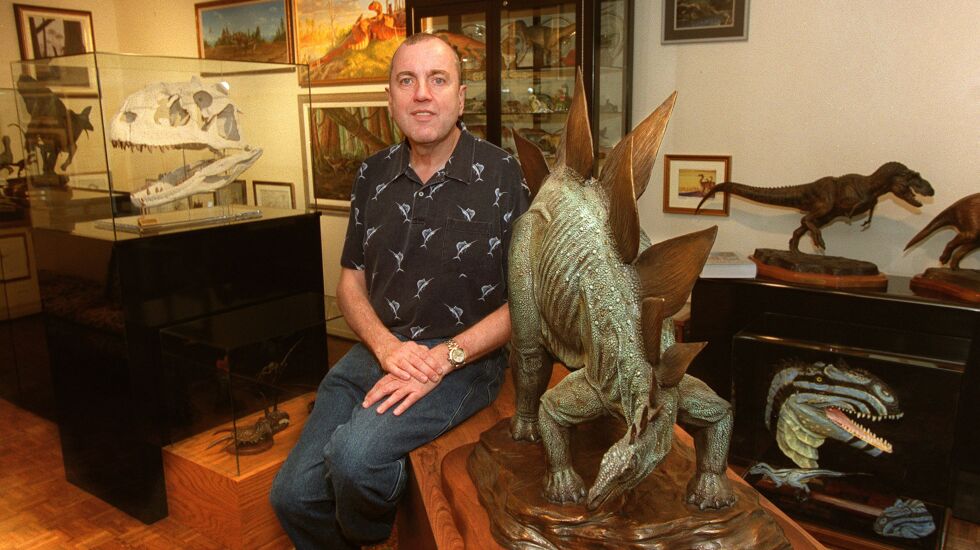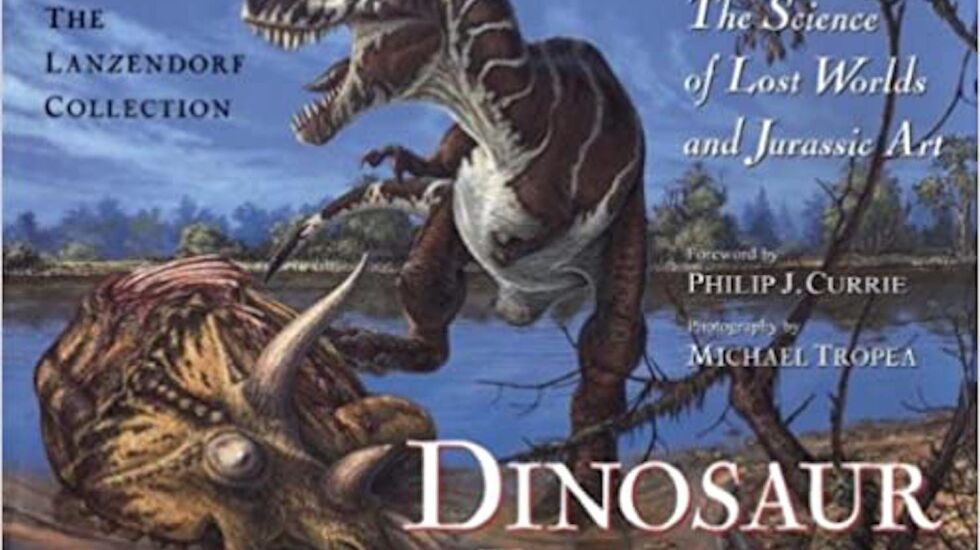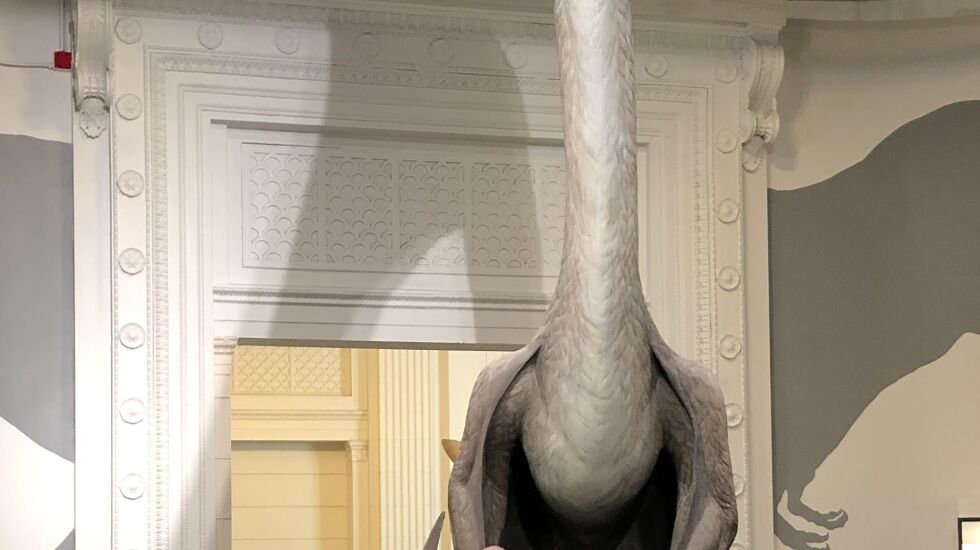
John Lanzendorf knew about beauty and also the beasts.
A Chicago hairdresser to society women and movie stars, he amassed one of the world’s finest private collections of dinosaur art, with pieces so scientifically accurate they were displayed in museums. He forged friendships with paleontologists, visited their digs and once said he could name 700 dinosaurs.
Some of his works were created by the artists and magic makers who helped bring dinosaurs to life in “Jurassic Park” and other movies.

His passion for the prehistoric wound up filling every table and wall of his 1,250-square-foot condo in the 200 block of East Pearson Street.
One display case held the origin of the species: little, green plastic dinosaurs he started collecting as a little boy.
“I got a dinosaur in a cereal box,” he once told the Chicago Sun-Times, “and I’ve been hooked ever since.”

“Lanzy” collected friends and loyal clients the same way he collected “paleo art.”
He worked as a hairdresser at Gold Coast salons, where his customers included Jane Fonda, Rita Hayworth, Angela Lansbury, Bette Midler and Rudolf Nureyev.
And he did hair for photo shoots by Victor Skrebneski, according to his friend Richard Wilson, an architect with Adrian Smith + Gordon Gill Architecture.
He styled stars appearing at the Chicago International Film Festival like Leslie Caron, Claudia Cardinale, Catherine Deneuve, Deborah Kerr and Marcello Mastroianni.
“I’d send them over to John, and they all loved him,” said film fest founder Michael Kutza, who owns a life-size, fiberglass head of a T. rex that Mr. Lanzendorf gave him as a gift.
Mr. Lanzendorf, who’d been diagnosed with pancreatic cancer, died May 27 at Northwestern Memorial Hospital after complications from surgery, according to friends. He was 76.
Hundreds of his pieces are at the Children’s Museum of Indianapolis, which called them “the world’s largest collection of paleo art” after buying them in 2002. Some are featured in a new “Dinosphere” exhibit that opened there in March.
Chicagoans saw some of his acquisitions in 2000. When the exhibition for Sue, the Tyrannosaurus, debuted at the Field Museum, his T. rex art also went on display.

“His collection is without equal and certainly the most important in the country, if not the world,” then-Field Museum CEO John W. McCarter Jr. said in a 2000 book about Mr. Lanzendorf’s collection, “Dinosaur Imagery: The Science of Lost Worlds and Jurassic Art.”
The publisher, Academic Press, said of Mr. Lanzendorf: “His collection and admittedly obsessive interest in dinosaurs are without equal.”

He even had a Velociraptor tattoo on his upper arm, according to his friend Peter Makovicky, a paleontologist and professor at the University of Minnesota who formerly worked at the Field Museum.
“John’s own words would be, ‘You know, I’m a little crazy,’ ” Makovicky said. “He would go all-in if he fell in love with a topic or hobby.”

“John had a contagious personality, a welcoming manner and a fashion and arts side to him that was appealing to the many in Chicago whose lives he touched,” University of Chicago paleontologist Paul Sereno said. “Chicago lost a dear friend but benefited from his many connections and the art he so dearly loved, collected and then moved to a permanent museum home.”
Young John grew up in Spooner, Wisconsin.
“On his 18th birthday, he got a bus to Chicago, where he would go on to have a 56-year career as a hair stylist to the ‘who’s who,’ ” Wilson said.
After cosmetology school, he worked at Bonwit Teller, Jon L. Goodman’s salon, the Lanzendorf Blankenship salon and most recently Elizabeth Adam at Water Tower Place.
“You had to be invited to have him cut your hair,” his friend Janet Murphy said. “He only wanted people he liked.”
“Everybody talks about writing the John Lanzendorf jokebook because he would hear these naughty jokes from rich women in Chicago,” said his friend Douglas Van Tress, co-owner of The Golden Triangle imports. “The sweetest, most sophisticated people were telling him these outrageous jokes with a 1970s air about them.”
Van Tress said he became friends with him after Mr. Lanzendorf bought a dinosaur egg from his art and design boutique.
“He collected all kinds of things,” he said. “But I realize his real genius was putting people together.”
“I’ve never known anyone with more friends and such a joy to connect one to the other,” Wilson said. “He had hundreds of friends of every age bracket and profession.”
He’d host birthday parties at Sayat Nova or Pelago Ristorante.
“He would start to toast everyone who was there and tell a story about how he met them all, and he would wind up weeping,” his friend Tom Murphy said. “He’d get overwhelmed.”
Mr. Lanzendorf might introduce friends to the person who would sell them their dream homes. Or he might make another kind of match, pairing friends with the perfect pet.
Makovicky and his wife Sushma Reddy stopped in at the Anti-Cruelty Society with Mr. Lanzendorf once, looking for a dog to adopt. “Lanzy” zeroed in on a friendly, calm dog. The couple walked out with him.
“Odin was our dog for the next 14 years, a yellow Lab-pit mix, the gentlest dog,” Makovicky said. “John saw that in him in like a minute.”
He was a regular at meetings of the Society of Vertebrate Paleontology, which manages an award he helped create: the Lanzendorf-National Geographic PaleoArt Prize.
It’s “the only award in the discipline given to artists,” said Jessica Theodor, the president of the society, “and has stimulated a great deal of wonderful work.”
“He supported those of us artists that had a desire to bring dinosaurs back to life during a time when paleo art was not accepted as a legitimate art form by the art community,” said Mike Trcic, who helped create T. rex effects for “Jurassic Park.”
“John made many of us all feel like rock stars,” said David Krentz, who worked on the 2000 Disney movie “Dinosaur” and on storyboards for 14 Marvel projects. “He was one-of-a-kind, eccentric, loving, funny, generous and fully embraced himself and others.”
Friends said he funded scholarships for dozens of young students in China, which he’d visited on a museum fossil expedition.
After the Children’s Museum of Indianapolis bought his collection, Mr. Lanzendorf pivoted to collecting Asian art.
He also kept rare parrots, cockatoos and macaws and two Grand Basset Griffon Vendéen dogs. One was named Louis because the breed was French. Mr. Lanzendorf, a tennis fan, named the other Rafa for tennis star Rafael Nadal.
“I’m always asked what’s so great about dinosaurs since they didn’t survive,” Mr. Lanzendorf once said in an interview with the Indianapolis Star. “Dinosaurs ruled the earth for 160 million years, and they’ve been gone 65 million years. Man has been here three to five million years, and in the last 100 years we’ve destroyed half the planet. We should be so happy to be as successful as the dinosaurs.”








